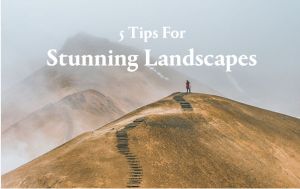5 Tips for Stunning Landscapes
This month’s article is courtesy of KEH Camera

Photo by Alexander Milo
The best examples of landscape photography should transport the viewer. That’s easier said than done. Read on for some tips on getting the shot that may end up as someone’s computer screen background someday.

 From left to right, photos by Adrian Pelletier, Thomas Tucker,
From left to right, photos by Adrian Pelletier, Thomas Tucker,
Cassie Boca and Vincent Vangok
Tip 1: Don’t Be Lazy
Find the right location. Whether hiking to the top of a mountain or finding the perfect clear spot overlooking a lake, sometimes it takes a little extra effort to get to that perfect vantage point.
 From left to right, photos by Dave Hoefler, Gemma Evans,
From left to right, photos by Dave Hoefler, Gemma Evans,
Matheo JBT, and Cassidy Dickens
Keeping your aperture around f/16 or smaller will make it easier to get more of that sweeping landscape in sharp focus. Wide apertures are beautiful in the right context, but nobody’s looking for bokeh in this scenario.
Tip 3: Get The Gear
Your ideal landscape images have a ton of details. High-resolution digital cameras really shine here. However, there’s nothing quite as organic as shooting nature on medium- or large-format film. No matter your medium, you’ll want a steady tripod and a wide-angle lens to capture the full moment.

Tip 4: Slap a Filter On It
A circular polarizer can be a game-changer to landscape photographers by reducing UV glare from bright skies and reflections on water & leaves to keep colors looking deep and rich.
Neutral Density filters are also a great addition to the landscape shooter’s kit. Not only do ND filters add versatility, but they can also allow you to keep your shutter speed long, smoothing out waves in those flowing water sources.
 Photo by Daniel J. Schwarz
Photo by Daniel J. Schwarz
To make sure you’re capturing and preserving as much detail as possible, use the lowest ISO possible to prevent any extra digital noise. If you aren’t already, consider shooting your landscapes in RAW digital format. This adds an extra step in the editing process, but it preserves more information from the original capture, giving the shooter more flexibility and control over the final look of the image.
Visit KEH Camera at: https://www.keh.com/
